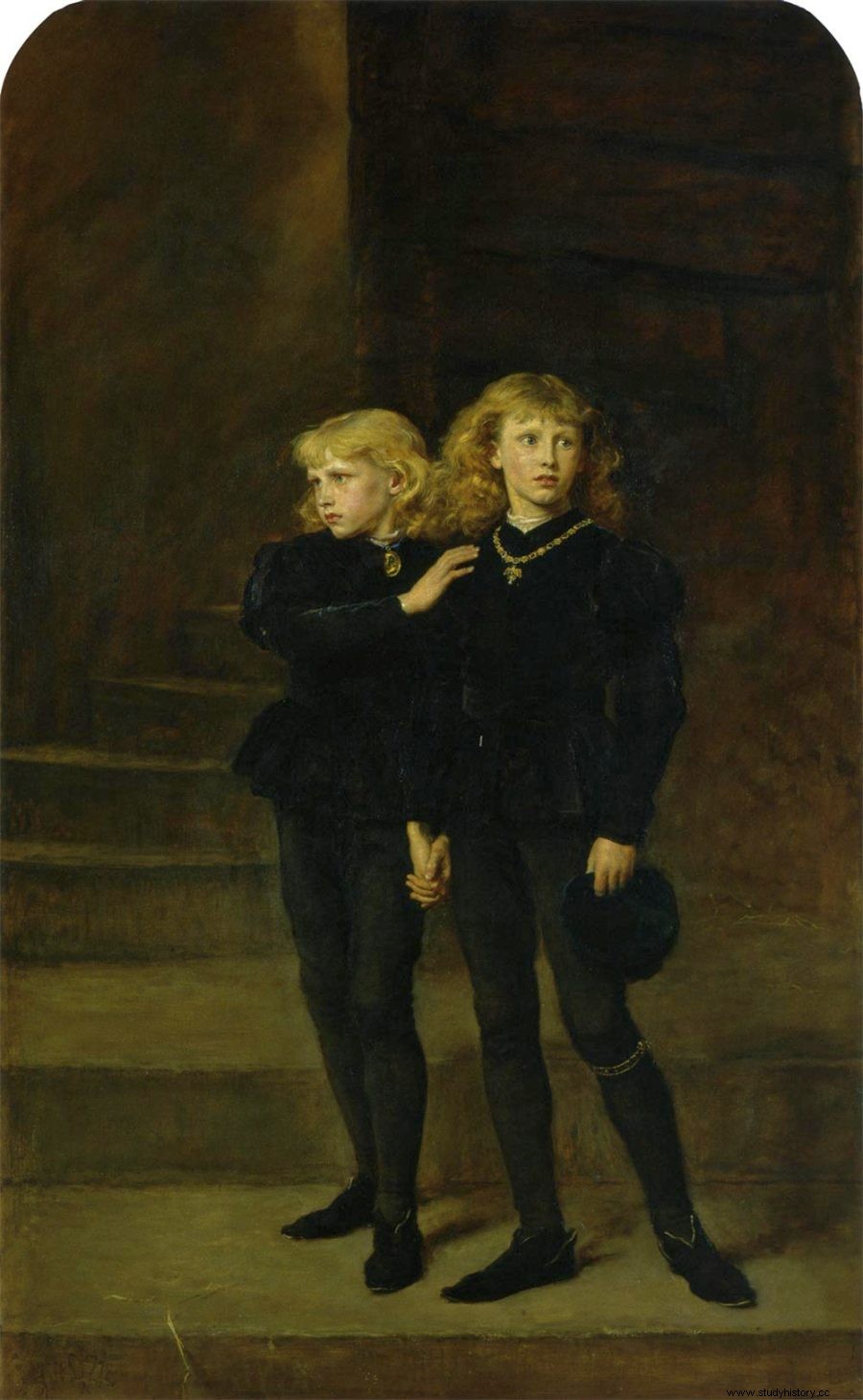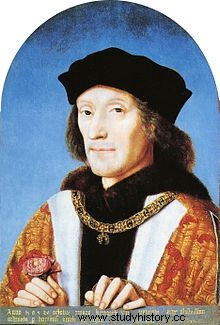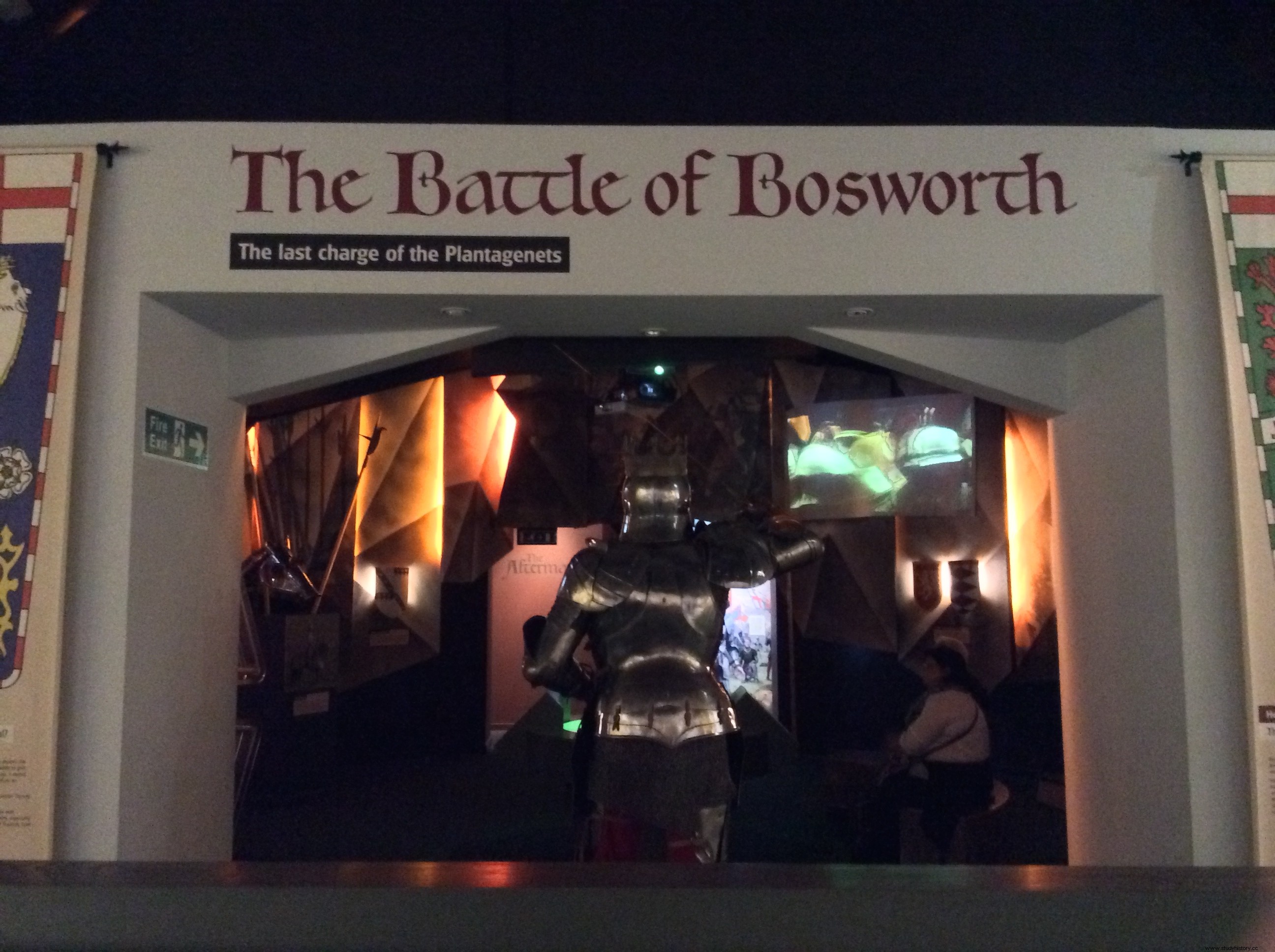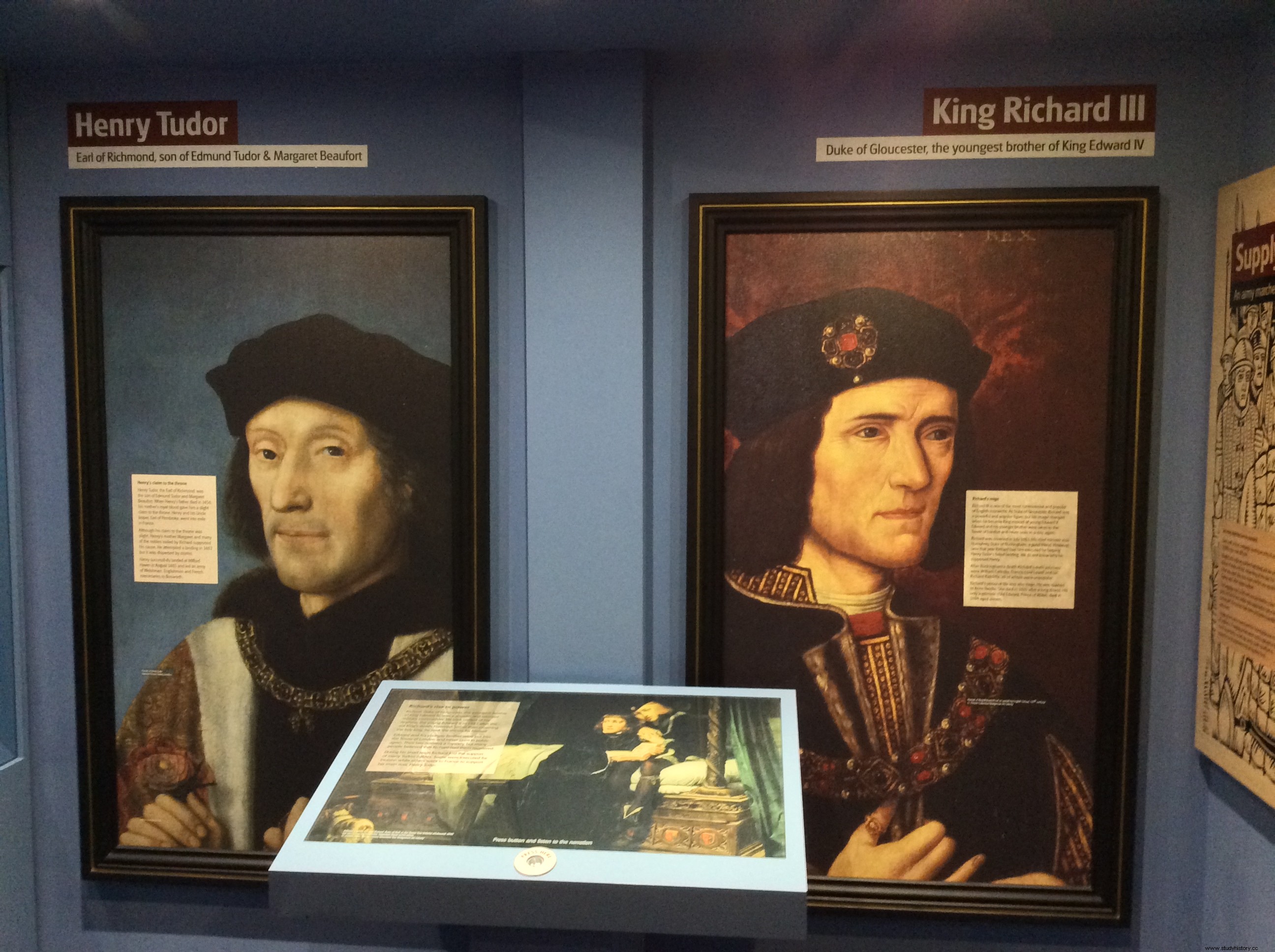Third and last entry that closes the series dedicated to the origin of the Tudory dynasty to Margaret Beaufort. We pick up where we left off the second, after the death of Edward IV and the accession to the throne of Richard III.
6.- The short but troubled reign of Richard III and the presentation of Henry Tudor's candidacy to the throne
The barely two years in which Richard III took the crown constitute one of the most convulsive and controversial periods, still today, in the history of England. Richard was not destined to ascend the throne on the death of his brother Edward IV, an honor that belonged to the eldest son of the deceased, Edward V. But the new king was a minor and his father had conferred on his brother Richard the role of Protector of the King. Kingdom to help and protect his young nephew.

Ricardo, probably suspecting a plot by the mother of the king, Isabel Woodville, to deprive him of the government and direct the destinies of the country together with his extended family, acted quickly. He intercepted at Stony Stratford the procession accompanying Edward V to be crowned in London, led by Lord Rivers, brother of Elizabeth Woodville. He took charge of the child and arrested and executed Rivers, as well as other supporters of the queen dowager (including Richard Grey, son of Woodville's first marriage) and some faithful supporter of Edward IV, such as William Hastings.
Upon learning of the situation, the dowager queen took refuge in holy in Westminster along with the rest of her children. Richard arrived in London and had his nephew installed in the Tower of London (then more of a royal residence than a prison) pending his coronation. He convinced Woodville to allow Edward V's brother Richard to join Edward V in the Tower.
Before the coronation ceremony took place, a priest introduced himself saying that when Edward IV had married Elizabeth Woodville he was already married (in a secret ceremony with a woman named Eleanor Butler), so the union with Woodville would be null and, therefore, their illegitimate descendants. Ricardo took the story to Parliament and Parliament passed a resolution called Titulus Regius by which the union between Eduardo and Woodville was declared null and separated from the right to the throne to his children, including Eduardo V. The Parliament granted the crown to the brother of the deceased king, that is to say to Ricardo III.

What happened to those known as princes of the Tower of London after they were declared illegitimate is still today, more than five hundred years later, the subject of heated debate in England. For centuries, especially since the works of Thomas More and Shakespeare, Richard III was held responsible for his murder. But in recent years, various movements have tried to vindicate the vilified figure of this monarch and point to other possible culprits in the death of the boys (such as the Duke of Buckingham or Margaret Beaufort herself) and even point out the possibility that the princes did not die in the Tower and returned years later in the figures of the pretender to the throne Lambert Simnel and Perkin Warbeck. The question of the princes would give for a book and in no case would be conclusive about their destiny and who is responsible for it.
Rumors about the fate of the princes, together with Richard's maneuvers to ascend the throne and the execution of popular men such as Lord Rivers or William Hastings, made the new monarch earn the enmity of the tycoons of the kingdom.
Among the men initially detained by the new monarch was Thomas Stanley, but after protests of loyalty to Richard he was released. Despite the obvious threat that her son posed as a hitch pennant for those dissatisfied with the situation, Margaret Beaufort was distinguished with the highest honors, for example during the coronation ceremony of Richard and her wife Anne Neville. /p>
But Margaret was already hatching a plot against the king and in favor of her son in order for him to wear the crown. She had the support of her former husband's nephew, Henry Stafford, Duke of Buckingham. He could wield a claim to the throne at least as good, if not better, than Henry Tudor's and, in theory, he was a staunch ally and supporter of Richard III, whose right-hand man he had become.
The authors speculate on his motives for allying himself with the Tudor faction, from being denied the title of Earl of Hertford to Richard dismissing his proposal to promise the Stafford's daughter with the king's son and heir, going through an attack of jealousy for not having been chosen to ascend the throne after the death of Edward IV. Some also point out that he was convinced by a furious enemy of Richard III who was in his custody, John Morton, Bishop of Ely. Be that as it may, Buckingham was an essential part of the plot to depose Richard III and crown Henry Tudor.
Margaret, well aware of the need for internal support, had contacted the Dowager Queen Elizabeth Woodville. Both women were able to put aside their differences and seek mutual interest. Woodville could influence Edward IV's loyalists to renounce Richard III and side with Margaret Beaufort's son.
Dan Jones explains very clearly how extraordinary the situation had to be for her claim to be supported:
It was a sign of the distress that had befallen the English crown that anyone even considered Henry Tudor as a possible candidate for the throne. . His father Edmund was a half brother of Henry VI and her mother Margaret Beaufort had a small part of Plantagenet blood. In ordinary circumstances these facts could hardly have cemented a sufficiently strong dynastic claim to claim the crown. In 1483 Henry was essentially the heir to a small and disreputable Welsh Lancastrian family, he had spent his life in the castles of South Wales and Brittany unknown to most English people. But Richard III's usurpation of the crown had broken all the rules of political correctness and opened up new and previously unfeasible possibilities.

It was agreed that if Henry Tudor managed to reach the throne, he would marry the eldest daughter of Edward IV and Woodville, Elizabeth of York. This marriage would unite the two branches of the York and the Lancastrians and would symbolize the end of the Wars of the Roses. In addition, it should not be forgotten that Henry had spent almost half his life in exile on the continent and that he was unknown in England. Joining his cause with the heiress of Edward IV (if, as it seemed, the princes of the Tower had been assassinated), endowed the suitor with a patina of legitimacy and ensured the sympathy of a significant number of undecided notables. Q>
The conspirators offered the Duke of Brittany more money to free him and Henry than Richard offered him for his continued imprisonment, which left the Tudor with freedom of movement to carry out his assault to the throne.
The attempted invasion of England took place in October 1483 and was a resounding failure. The fleet that transported Enrique and his men suffered from inclement weather and was scattered. Meanwhile, the main internal support of the invasion, the Duke of Buckingham, saw how between the bad weather and the desertions his strength was diluted like a sugar cube. Stafford was arrested and executed.
We would have to wait for a better occasion and, above all, more thoroughly prepared.
7.- The Battle of Bosworth:the «Stanley factor» and the rise to the throne of Henry Tudor
The disastrous adventure of October 1483 did not persuade the Tudor party of their intentions to gain the crown. Richard had reacted to the invasion by having Parliament condemn all those involved in the rebellion as traitors. This included Margaret Beaufort, but not Stanley, who had remained on the sidelines of Buckingham's maneuvers.
The desire not to lose such a powerful ally (and his not inconsiderable military contingent) meant that the king was not more forceful in his actions against Margaret Beaufort. Instead of being sentenced to death and her assets confiscated by the crown, Richard decided to subject her to a kind of perpetual house arrest under the guardianship of her husband, to whom all of Margaret's assets were awarded.
Meanwhile the king launched a diplomatic offensive to get the Duke of Brittany to hand over Henry Tudor. Margaret was notified through her husband, she had just time to warn her son to flee to France hours before being arrested by the Bretons.
The king also managed to get closer to his sister-in-law Elizabeth Woodville whom he convinced to leave the untenable situation in which she and her daughters found themselves in their foster care in Westminster and They joined the court. In fact, Woodville even wrote to one of her sons from her first marriage to leave the exile in which she was with Henry Tudor and return to England with Richard.
Despite these efforts to gain support, the situation of the monarch in England was not easy. The manner in which he came to the throne, the executions he had carried out, the rumors about the fate of the princes in the Tower, and the gossip about his intention to marry his own niece Elizabeth of York (his wife, Anne Neville, had who died in March 1485 and there were those who claimed that the king had her poisoned) created an unpopular image of Richard, which the Tudor party used as propaganda to gain support for a new assault on the throne.
And they needed it. In his French exile, Henry Tudor met the politician Philippe de Commynes, who described the suitor as a penniless man, worn out by years of exile and with a speech more typical of a man resigned to his sad fate than of a king. in exile willing to regain his right to the throne.
In these conditions, when Henry re-invaded England through Wales on August 7, 1485 at the command of a heterogeneous group of mercenaries, the forces of one side and the other They were very balanced. And this was where, thirteen years later, Margaret Beaufort's wisdom (or luck) was demonstrated in choosing Thomas Stanley as her husband.
Richard, eager to put an end to rumors that he wanted to marry his niece, had sent Elizabeth of York to the London home of Thomas Stanley. It was a mistake. Although Margaret Beaufort was not there, talks quickly began to involve the powerful party of the Stanleys in the Tudor cause (it is estimated that they could contribute an armed contingent of between three thousand and five thousand men). When Richard reacted and sent Elizabeth to a castle in Yorkshire it was too late to prevent harm.
Upon learning of Henry Tudor's landing at Milford Haven, Richard demanded that Thomas Stanley's eldest son be given to him as a hostage to try to secure his father's support. Henry was adding allies (especially in Wales, due to the presence of Jasper Tudor) to the force of French mercenaries with which he arrived.
Ricardo summoned all the tycoons of the country in Nottingham. Thomas Stanley refused, claiming to be ill, but he did not decide to openly support the Tudor either, worried about the fate of his son. Stanley's brother, William, in charge of the important military contingent that the family controlled, also did not respond to the king's call, but went directly to the place where the confrontation was to take place.
Finally the armies of Richard III and Henry Tudor met at Bosworth on August 22, 1485. In the first moments of the battle William Stanley's forces remained untouched , joining neither Richard nor Henry's army.

 Portraits of the Bosworth Contenders Richard III and Henry VII
Portraits of the Bosworth Contenders Richard III and Henry VII When they finally moved, they did so to join the camp of Thomas Stanley's stepson. Seeing themselves lost, Richard's servants offered him a horse to flee, but the monarch replied that on that day he would live or die as king. And indeed that day Richard III, the last Plantagenet, left the crown and life on the battlefield of Bosworth. The dynasty that had ruled England since 1154 and that had produced such important kings as Henry II, Richard the Lionheart, John the Landless and Edward I was giving way to a new royal family.
On October 30, 1485, Henry VII was crowned at Westminster. There he was reunited with the mother whom he had not seen for fourteen years. Margaret Beaufort could not hold back her tears at the happy culmination of the improbable project of making her son king of England.
Conclusion
In telling the story of the Tudor dynasty's accession to the throne, one loses count of the number of conditionals that could have prevented Henry VII from taking the crown. If Catherine de Valois had not started a love affair with Owain Tudur, if Henry VI had not inherited his maternal grandfather's mental illness, if Margaret Beaufort had married William de la Pole's son, if the birth of a weak A thirteen-year-old girl would have gone wrong, if the Wars of the Roses had not so radically beheaded the Lancastrians and the Yorks, if the men sent by Richard III to arrest Henry Tudor in Britain had arrived a few hours earlier, if Richard had not Margaret Beaufort's life spared after the failed invasion of 1483, if the Stanleys had chosen to remain faithful to Richard III... everything could have been different. But it was not, and as a consequence the reign of the famous Tudor dynasty began.
Image | Author's archive. Wikipedia
Fonts|
Daniel Fernandez deLis. What Shakespeare didn't tell you about the Wars of the Roses . Madrid, Libros.com, 2020
Daniel Fernández de Lis. The Plantagenets . Madrid, Libros.com, 2018.
Dan Jones. The Hollow Crown. The Wars of the Roses and the rise of the Tudors. London, Faber &Faber Limited, 2015.
Plantagenets , The Kings Who Made England . London, Ed. William Collins, 2012.
Peter Ackroyd. A History of England. Volume I (Foundations). London, Ed. McMillan, 2011.
Roy Strong. The Story of Britain. London, Pimlico Ed., 1998.
Simon Schama. A History of Britain. London, BBC Worldwide Limited, 2000.
Derek Wilson. The Plantagenets, The Kings That Made Britain . Ebook edition, London, Quercus Edition Ltd., 2014
Nathen Amin. The House of Beaufort. The Bastard Line that Captured the Crown. Stroud, Amberley Publishing, 2017.
Elizabeth Norton. Margaret Beaufort, Mother of the Tudor Dynasty. Stroud, Amberley Publishing, 2011.
Thomas Penn. Winter King, The Dawn of Tudor England. London, Penguin Books, 2012.
Alicia Carter. The women of the Wars of the Roses. Ebook Edition, Editor Alicia Carter, 2013.
